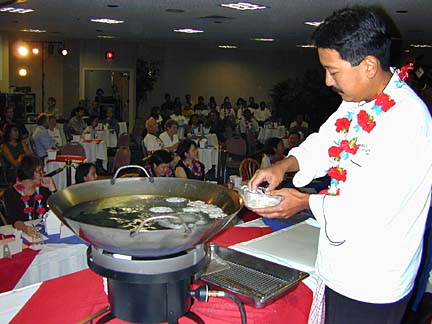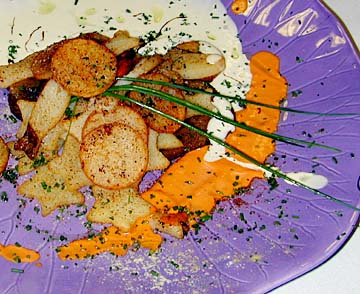Advertisement - Click to support our sponsors.



By Betty Shimabukuro
Star-Bulletin
RICE AND POTATOES. Two starches; two staples.With the advent of the French Festival and all the mixing up of cultures going on, it seemed a prime time to explore the multicultural possibilities of a couple of everyday carbs.
Our first adventure was a private challenge carried out at the Halekulani hotel.
Working there this week, alongside La Mer chef Yves Garnier, is guest chef Joël Garault of Hõtel Hermitage in Monte Carlo.
These are two men who rarely work with rice, have never rolled sushi and never eat Spam. The perfect pair for the Star-Bulletin's first Musubi Challenge, in which we seek out new and audacious ways to serve up Spam musubi. We hope to compile a varied collection over the course of the next few months, depending upon the good sportsmanship of chefs both visiting and resident.
Garnier and Garault were charged with creating something out of rice and nori, in the rectangular image of a Spam musubi, except that they didn't have to use Spam.

"Musubi -- what is musubi?" Garault said in recalling his introduction to the dish. "I don't know. I don't know Spam."But he was game. The two chefs used ahi, smoked salmon, scallops and that most French of ingredients, foie gras, in their pseudo-sushi.
Would Garault serve it at his restaurant, Belle Epoque in Monte Carlo? "It's an interesting idea ... maybe. Maybe, maybe ..."
Adventure No. 2: The French Fry Fry-Off held at the Pacific Beach Hotel over the weekend.
In this event, local chefs were invited to come up with their best fried nuggets, in the image of the french fry, but not necessarily using potatoes.
Still, everyone did use potatoes, except Randal Ishizu of the Ihilani Resort & Spa, who fried up some Nori-Wrapped Ahi "French Fries" and ended up taking first place.
What do french fries have to do with France? The French do eat them, said Eric Leterc, the hotel's executive chef.
"The traditional plate is steak, fries and salad and you find it at any bistro." With ketchup? "Yes, ketchup," Leterc said. "And mustard."
The invention of the deep-fried potato is credited historically both to the French or the Belgians, but either way by the 1830's deep-fried potatoes (pomme frites) had grown popular in both countries. Thomas Jefferson is said to have served them at Monticello as early as 1802, but they didn't really catch on in this country until well into the 1900s when American soldiers brought back a taste for them after serving in Europe during World War I.

Today, of course, they are so dearly loved that some Americans consider them a food group in themselves.Of preeminent concern in the making of good fries is choice of oil, consistency of heat and choice of potatoes, the cooks agreed.
Sean Kinoshita of Sansei Seafood Restaurant & Sushi Bar chose cottonseed oil and russet potatoes for his tempura-like presentation.
"Cottonseed is good for tempura because it has no flavor," Kinoshita said. "You want it to showcase the product you choose."
Russets also are mild, he said, so his end result was a fry that would pair nicely with his spicy kochojang vinaigrette sauce.
George Gomes of A Pacific Cafe Maui, on the other hand, chose olive oil and Yukon Gold potatoes because of their upfront taste, the better to show off his traditional Portuguese potato-cod cakes.
"Olive oil is used a lot in Portuguese cooking because it adds a lot of fruity flavor," Gomes said. Yukon Golds are creamy and buttery and he cooked them with salt to accent the creaminess.
The chefs recommended a frying temperature of 350 to 375 degrees and gas burners. If your range is electric, consider investing in a single propane-fueled burner. It has the added benefit of being portable, so you can take the smelly aspects of frying outside.
Back to the French musubi: The plates are displayed on a white tablecloth, adorned with flowers. Randy Ching, cellarmaster for La Mer, selects a champagne, Veuve Clicquot Ponsardin, "for French purposes," although his first thought was a German Riesling Kabinett Mosel, which is more of a sushi wine.
Garault has used his musubi mold, placing a scallop wrapped in a very, very thin slice of carrot at the center. His rice is flavored with salt, pepper and soy sauce, with minced zuchini.
Garnier has layered sauteed foie gras with raw ahi. Sliced, it looks very much like Spam musubi.
In a second presentation, he's used a ring to mold up layers of rice, smoked salmon, grilled bell pepper and cucumber. Between each layer is a sheet of nori.

The dishes are classically presented with colorful sauces and swirly garnishes. The middles are tasty, but unfortunately these chefs don't seem to have an affinity for rice. It is not to them, as it would be for a Japanese chef, the true center of the dish. No sweet vinegar flavoring here, and the texture wouldn't pass the plate-lunch standard.Still, Fred Honda, general manager of the hotel, seems to be seriously considering asking Garnier to fine-tune the seasonings and perhaps offer his foie gras musubi as a La Mer amuse bouche -- a sort of mini-appetizer served before the appetizer.
No mention of Spam as part of the bargain.
"It is all right," Garnier says of the gelatinous log. "I prefer foie gras, of course."
Culinary students share
day with French chefs

Between musubi duties, chefs Yves Garnier and Joël Garault taught cooking classes in the La Mer kitchen.Monday's class was a special event for a select group of 12 students from Kapiolani Community College's culinary program. They all were advanced students chosen by their instructors.
Two students, Kimi Werner and Lawrence Aragon, were awarded monthlong internships in the La Mer kitchen.
Click for online
calendars and events.